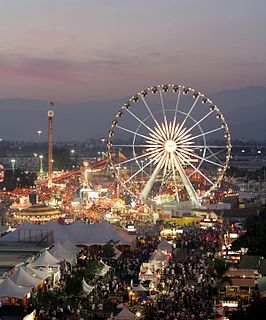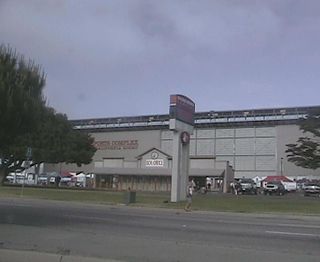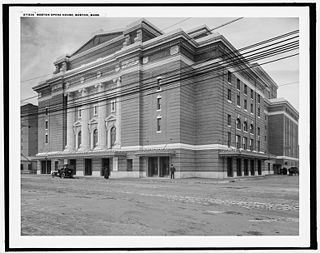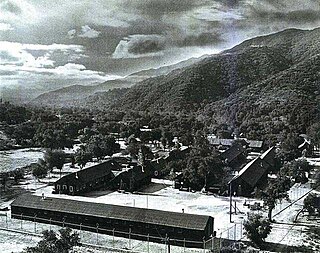Related Research Articles

Holbrook is a town in Norfolk County, Massachusetts, United States. As of 2020, the town's population was 11,405.

The Federal Correctional Institution, Seagoville is a low-security United States federal prison for male inmates in Seagoville, Texas in the Dallas-Fort Worth metropolitan area. It is operated by the Federal Bureau of Prisons, a division of the United States Department of Justice. The facility includes a detention center for male offenders and an adjacent satellite prison camp that houses minimum security-male offenders.

Camp Harmony is the unofficial euphemistic name of the Puyallup Assembly Center, a temporary facility within the system of internment camps set up for Japanese Americans during World War II. Approximately 7,390 Americans of Japanese descent from Western Washington and Alaska were sent to the camp before being transferred to the War Relocation Authority camps at Minidoka, Idaho, Tule Lake, California and Heart Mountain, Wyoming.

Wood Island station is a rapid transit and bus station on in Boston, Massachusetts. It serves the MBTA Blue Line and the MBTA bus system. It is located off Bennington Street in the Day Square section of East Boston. The station also serves as a bus transfer point for several local routes.

Fairplex, known prior to 1984 as the Los Angeles County Fairgrounds, has been the home of the L.A. County Fair since 1922. It is located in the city of Pomona, California. The L.A. County Fair is now held during the month of May come 2022, but the facility is used year-round to host a variety of educational, commercial, and entertainment such as trade and consumer shows, conventions, and sporting events.

Pinedale is a previously unincorporated community in Fresno County, California. It lies at an elevation of 348 feet. It was once a rural community located on the Southern Pacific Railroad 3.5 miles (5.6 km) north-northwest of Clovis but has since become surrounded and annexed by the city of Fresno. Millerton Lake State Recreational Area is to its NE. The ZIP Code is 93650, and the community is inside area code 559.

The Salinas Sports Complex is a sporting complex located in Salinas, California on the Central Coast. The main feature of the complex is a 17,000-seat stadium for California Rodeo Salinas. Soccer, football, and rugby was also played at the main stadium before the opening of Rabobank Stadium next door.

North Truro Air Force Station (AFS) is a closed United States Air Force General Surveillance Radar station. It is located 2.2 mi (3.5 km) east of North Truro, Massachusetts.

Arboga is an unincorporated community in Yuba County, California. It is located 3 miles (4.8 km), south of Olivehurst on the Sacramento Northern Railroad, at an elevation of 56 feet. It was named in 1911 by the pastor of the Mission Covenant Church of Sweden for his hometown of Arboga, Sweden.

Angel Island Immigration Station was an immigration station in San Francisco Bay which operated from January 21, 1910 to November 5, 1940, where immigrants entering the United States were detained and interrogated. Angel Island is an island in San Francisco Bay. It is currently a State Park administered by California State Parks and a California Historical Landmark. The island was originally a fishing and hunting site for Coastal Miwok Indians, then it was a haven for Spanish explorer Juan Manuel de Ayala. Later, it was developed as a cattle ranch, then, starting with the Civil War, the island served as a U.S. Army post. During the island's Immigration Station period, the island held hundreds of thousands of immigrants, the majority from China, Japan, India, Mexico and the Philippines. The detention facility was considered ideal because of its isolated location, making it very easy to control immigrants, contain outbreaks of disease, and enforce the new immigration laws. The station is listed on the National Register of Historic Places under the title Angel Island, U.S. Immigration Station, and is a National Historic Landmark. The station is open to the public as a museum – "a place for reflection and discovery of our shared history as a nation of immigrants".

Crystal City Internment Camp, located near Crystal City, Texas, was a place of confinement for people of Japanese, German, and Italian descent during World War II, and has been variously described as a detention facility or a concentration camp. The camp, which was originally designed to hold 3,500 people, opened in December 1943 and was officially closed on February 11, 1948.

Fort Andrews was created in 1897 as part of the Coast Defenses of Boston, Massachusetts. Construction began in 1898 and the fort was substantially complete by 1904. The fort was named after Major General George Leonard Andrews, an engineer and Civil War commander, who assisted in the construction of nearby Fort Warren in Boston Harbor. It occupies the entire northeast end of Peddocks Island in Boston Harbor, and was originally called the Peddocks Island Military Reservation. Once an active Coast Artillery post, it was manned by hundreds of soldiers and bristled with mortars and guns that controlled the southern approaches to Boston and Quincy Bay. The fort also served as a prisoner-of-war camp for Italian prisoners during World War II, who were employed as laborers following the Italian surrender to the Allies in 1943. Today, the fort is abandoned, and is managed by the Massachusetts Department of Conservation and Recreation, as part of the Boston Harbor Islands National Recreation Area.

The Boston Opera House was an opera house located on Huntington Avenue in Boston, Massachusetts. It opened in 1909 as the home of the Boston Opera Company and was demolished in 1958 after years of disuse.

The South Boston Army Base, previously the Boston Quartermaster Terminal or Army Supply Base and in 1937 named the Boston Army Base, was a 58-acre United States Army annex located in South Boston. It was authorized in April 1918 and opened for operation in October 1918. The terminal was part of the Boston sub-port of the New York Port of Embarkation during World War I. During World War II, it was a component of the Boston Port of Embarkation. It ceased operation in 1974.

Camp Kohler was located in the northeast corner of unincorporated Sacramento County, California, United States, until it was destroyed by a fire in 1947. Initially a camp for migrant farm workers, it became the Sacramento Assembly Center a temporary detention center for interned Japanese Americans in 1942. The site is one of 12 California assembly centers that share designation as California Historical Landmark No. 934. From 1943 to 1945 the camp was a training center for US World War II forces.
The Catalina Federal Honor Camp, or Tucson Federal Prison Camp, located in the Santa Catalina Mountains, held men subject to the World War II incarceration of Japanese Americans. It had no security fence, boundaries were marked with stones painted white. 45 of the 46 prisoners were draft resisters and objectors of conscience transferred from camps in Colorado, Arizona and Utah, although Gordon Hirabayashi, who had challenged the exclusion of Japanese Americans from the West Coast, was also held here.

Tuna Canyon Detention Station was a temporary detention facility used for holding hundreds of Japanese Americans who were considered enemy aliens by the U.S. government and to be risks to the nation's security. The detention camp was located in Tujunga at a former Civilian Conservation (CCC) Camp, constructed in 1933. The camp was converted into the Tuna Canyon Detention Station just after the bombing of Pearl Harbor. Administered by the Department of Justice, it opened on December 16, 1941, when the first group of detainees arrived from various Southern California towns and cities. Tuna Canyon had a capacity of 300, and until its closing in October 31, 1943, over 2,000 Japanese, German, and Italian immigrants, Japanese Peruvians, and others were imprisoned there. Most were transferred to other DOJ facilities like Fort Missoula, Fort Lincoln and Santa Fe. The site was used as a probation school after the war.

The Temporary Detention Camp for Japanese Americans / Pomona Assembly Center is one of the places Japanese Americans were held during World War II. The Pomona Assembly Center was designated a California Historic Landmark on May 13, 1980. The Pomona Assembly Center is located in what is now called the Fairplex in Pomona, California in Los Angeles County. The Pomona Assembly Center was called Los Angeles County Fairgrounds in 1942.

The Temporary Detention Camp for Japanese Americans / Santa Anita Assembly Center is one of the places Japanese Americans were held during World War II. The Santa Anita Assembly Center was designated a California Historic Landmark (No.934.07) on May 13, 1980. The Santa Anita Assembly Center is located in what is now the Santa Anita Racetrack in Arcadia, California in Los Angeles County.
References
- 1 2 "East Boston Immigration Station Study Report" (PDF). City of Boston. Retrieved 24 December 2013.
- ↑ "East Boston" Densho Encyclopedia
- ↑ J. Burton, M. Farrell, F. Lord, R. Lord. Confinement and Ethnicity: An Overview of World War II Japanese American Relocation Sites, "Department of Justice and U.S. Army Facilities: Temporary Detention Sites" Archived 2014-11-06 at the Wayback Machine (National Park Service)